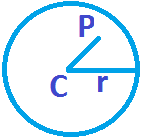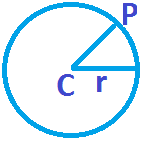Circles – Power of a Point
Let S = 0 be a circle with center C and radius r. let P be a point. Then CP² – r² is called power of P with respect to the circle S = 0.
Theorem: The power of a point P (x₁, y₁) with respect to the circle S = 0 is S₁₁.
Proof: Let S ≡ x² + y² + 2gx + 2fy + c = 0 be the given circle.
Centre C = (-g, -f)
and P (x₁, y₁)
CP = √ [(x₁ + g)² + (y₁ + f)²]
Squaring on both sides
CP² = (x₁ + g)² + (y₁ + f)² … (1)
Radius (r) = √(g² + f² – c)
Squaring on both sides
r² = g² + f² – c … (2)
from equation (1) and (2)
CP² – r²
= (x₁ + g)² + (y₁ + f)² – (g² + f² – c)
= x₁² + 2x₁ g + g² + y₁² + 2y₁f + f² – g² – f² + c
= x₁² + y₁² + 2gx₁ + 2fy₁ + c = 0
S₁₁ = x₁² + y₁² + 2gx₁ + 2fy₁ + c = 0
Let S = 0 be a circle and P be a point. Then
i) P lies inside the circle S = 0 if the power of P is negative.

ii) P lies on the circle S = 0 if the power of P is zero

iii) P lies outside the circle S = 0 if the power of P is positive.

Example: Find the power of (2, 3) with respect to x² + y² – 2x + 2y + 10 = 0
Solution: Given that,
S ≡ x² + y² – 2x + 2y + 10 = 0
Power of point is (2, 3)
we can use the formula S₁₁ = 0
S₁₁ = x₁² + y₁² – 2x₁ + 2y₁ + 10 = 0
Put x₁ = 2, y₁ = 3
S₁₁ = (2) ² + (3) ² – 2(2) + 2(3) + 10 = 0
S₁₁ = 4 + 9 – 4 + 6 + 10 = 0
S₁₁ = 25
Therefore, P lies outside the circle S = 0 if the power of P is positive.
